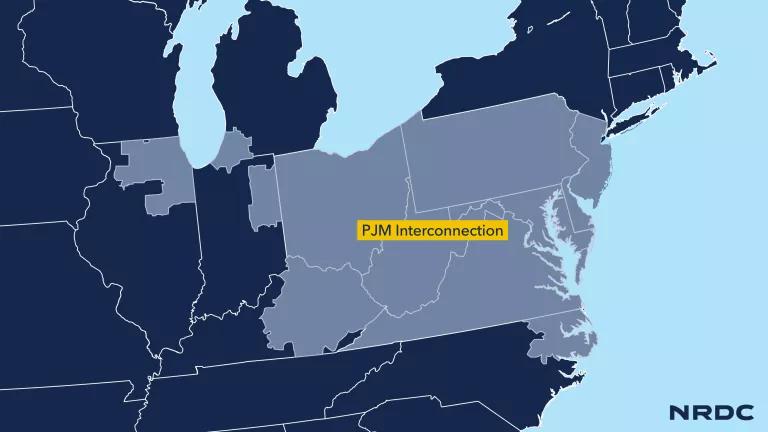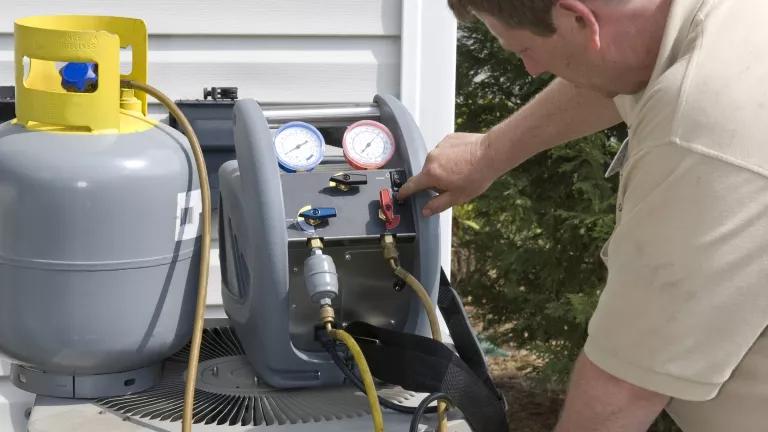The Window of Opportunity for Transmission at PJM Is Still Open
Five questions on PJM’S Long-Term Regional Transmission Planning you were worried about that seemed too stupid to ask—but aren’t.

NRDC
What’s PJM Interconnection?
PJM Interconnection is an electricity traffic manager for a big part of the eastern United States. It helps make sure that electricity is generated and delivered smoothly to homes and businesses in its region. Think of it as a giant coordinator that plans and directs how electricity moves around, making sure there's enough power for everyone and preventing problems like blackouts. PJM helps balance the supply and demand of electricity, keeping things running smoothly for millions of people.
PJM, the nation’s largest grid operator that covers 13 states in the Midwest and mid-Atlantic, is now taking a major step forward to identify its transmission needs and provide a road map to stakeholders and developers in its territory. PJM lags behind the rest of the nation in renewable energy, but ambitious goals in many PJM states—like Illinois, Maryland, New Jersey, and Virginia—promise to change that.
Utilities and the gas industry say coal and gas are more reliable than renewable energy, but the facts say otherwise. PJM is kicking off a process to both forecast how the demand for electricity will grow and change and to understand where new generation and storage are likely to be built.
What is Long-Term Regional Transmission Planning?
PJM is kicking off a process called Long-Term Regional Transmission Planning (LTRTP), which is designed to help it start planning the transmission system for 2030 and beyond. PJM hopes to forecast how the demand for electricity will grow and change, consider the retirement of old power plants, and understand where new generation and storage are likely to be built. Based on that, it will identify the transmission routes and pathways that will allow the new resources to connect to the grid and deliver power to where it’s needed. PJM's LTRTP is a way of preparing for the future to make sure there's enough reliable, efficient electricity for everyone in its region. Here's a breakdown:
- Planning for the future: PJM is looking ahead, forecasting how much electricity people will need in the coming years. This is like making sure there are enough roads for all the cars, but in this case, it's about having enough power lines and infrastructure to handle electricity demand.
- Regional transmission: "Transmission" refers to the high-voltage power lines that carry electricity over long distances. PJM looks at how these lines connect different areas in its region to ensure a smooth flow of electricity.
- Reliability and efficiency: PJM wants to make sure the electricity grid is reliable (meaning it works well without interruptions) and efficient (using resources wisely). Long-term planning helps identify areas where improvements or new power lines might be needed to keep the system running smoothly.
- Coordinating with stakeholders: PJM works with various stakeholders, like power companies, regulators, and the public, to get input and make informed decisions. This ensures that the plan reflects the needs and concerns of everyone involved.
What’s the process?
How do we get it right and make the most of this opportunity? If all goes well, PJM will take proactive responsibility for the major lines needed for the clean energy transition. If this and the cluster studies all work as planned, by the end of the decade, we should have a functional interconnection process. This can’t happen too soon since people are already feeling the effects of climate change.
The LTRTP process is just getting underway. The next few weeks and months will have a strong bearing on the timeline and outcomes of the overall process. PJM proposes to spend 2024 developing scenarios looking at years 2031–2040; put projects out to bid starting in mid-2025; and sign contracts in 2026.
We hope clean energy leaders across the PJM region—in Delaware, Illinois, Indiana, Kentucky, Maryland, Michigan, New Jersey, North Carolina, Ohio, Pennsylvania, Tennessee, Virginia, West Virginia, and the District of Columbia—get engaged and help shape the process.
Scenario planning will be the first major hurdle, and we eagerly wait for an opportunity to help shape the future of the energy mix in PJM. There is much work ahead, but this is an exciting time to mold the clean energy transition. Let’s get started.
How’s it Looking for clean energy? Is the process fair?
Right now, NRDC and others have some concerns, and PJM looks to be falling into some past patterns that benefit fossil fuel generators over the consumer. A few quick suggestions:
- PJM Interconnection should incorporate more improvements in long-term transmission like MISO did last year. For an example of the benefits that long-term planning can offer, just look to PJM’s neighbor to the west, MISO, the grid operator for a 15-state swath of the country, reaching from Louisiana to Minnesota. MISO kicked off its Long Range Transmission Planning in 2020 by identifying multiple future scenarios. In 2022, that process bore fruit with the announcement of its first of four major transmission build-out proposals, which are expected to facilitate 53 gigawatts of new renewable energy, including wind, solar, storage, and battery projects—enough to power 12 million homes. Estimated to cost $10.3 billion, MISO also estimates savings of $37.3 billion by way of an increased ability to move power around the region.
- Treat all state policies equally. It’s no secret that much of the renewable development in PJM is due to state policies incentivizing increased low-cost generation. But, at the behest of legislators from fossil-heavy districts, PJM is already backing off of its initial plan to treat all states and resources equally. Instead, it now proposes to cordon off clean energy policies into a separate planning process that makes planning for them optional and unfairly overcharges clean states. PJM had it right the first time: Clean energy policies are a part of the region’s future and should be treated on equal terms with all other drivers. If nothing else, it would be blatantly unfair to consider policies supporting fossil fuel in the baseline scenarios while pushing clean energy off into a corner. PJM should stick to its guns.
- Embrace energy leadership. The grid of our grandparents will not be the same grid for our grandchildren. The clean energy transition is a generation-defining task, and we need to be successful if we intend to stave off the worst impacts of climate change. Grid operators have an immense responsibility to help shepherd this transition, which goes far beyond the already immense task of managing the 24/7 operations of the electric grid. We hope PJM leadership seizes the opportunity to set a model for planning in regional transmission organizations and independent system operators across the country.
That doesn’t sound great. Does that mean we’re paying more for coal and corruption in Ohio rather than clean renewable energy?
Right now, PJM proposes to give special treatment to state policies that support existing power plants. For example, coal owner FirstEnergy bribed Ohio lawmakers to pass HB6, which creates a policy of subsidizing FirstEnergy’s coal plants. Transmission upgrades to support those power plants would be treated as mandatory and funded by ratepayers across PJM. On the other hand, new clean energy mandated by Illinois’s Clean Energy & Justice Act (and similar laws in Maryland and New Jersey) would be treated as optional, and Illinois ratepayers would have to pay the entire bill for any transmission to support them, even though they benefit other states. It’s entirely possible that the result of PJM’s proposal would be to require Illinois to first pay for transmission to support Ohio’s coal plants, then pay again for the transmission to build their replacements, while states like Maryland and New Jersey bend over backward to keep emissions-slashing, low-cost offshore wind plans afloat.




